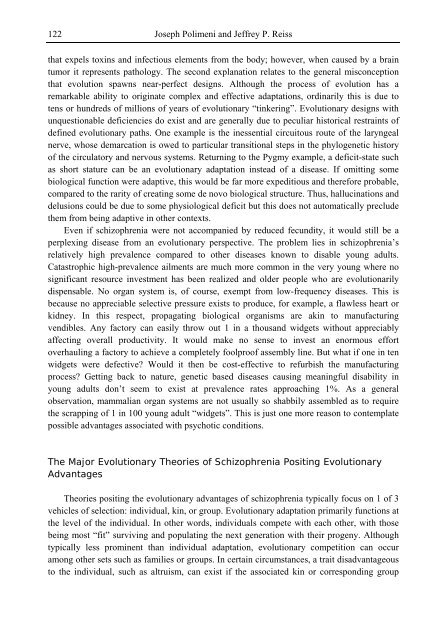Schizophrenia Research Trends
Schizophrenia Research Trends
Schizophrenia Research Trends
- No tags were found...
Create successful ePaper yourself
Turn your PDF publications into a flip-book with our unique Google optimized e-Paper software.
122Joseph Polimeni and Jeffrey P. Reissthat expels toxins and infectious elements from the body; however, when caused by a braintumor it represents pathology. The second explanation relates to the general misconceptionthat evolution spawns near-perfect designs. Although the process of evolution has aremarkable ability to originate complex and effective adaptations, ordinarily this is due totens or hundreds of millions of years of evolutionary “tinkering”. Evolutionary designs withunquestionable deficiencies do exist and are generally due to peculiar historical restraints ofdefined evolutionary paths. One example is the inessential circuitous route of the laryngealnerve, whose demarcation is owed to particular transitional steps in the phylogenetic historyof the circulatory and nervous systems. Returning to the Pygmy example, a deficit-state suchas short stature can be an evolutionary adaptation instead of a disease. If omitting somebiological function were adaptive, this would be far more expeditious and therefore probable,compared to the rarity of creating some de novo biological structure. Thus, hallucinations anddelusions could be due to some physiological deficit but this does not automatically precludethem from being adaptive in other contexts.Even if schizophrenia were not accompanied by reduced fecundity, it would still be aperplexing disease from an evolutionary perspective. The problem lies in schizophrenia’srelatively high prevalence compared to other diseases known to disable young adults.Catastrophic high-prevalence ailments are much more common in the very young where nosignificant resource investment has been realized and older people who are evolutionarilydispensable. No organ system is, of course, exempt from low-frequency diseases. This isbecause no appreciable selective pressure exists to produce, for example, a flawless heart orkidney. In this respect, propagating biological organisms are akin to manufacturingvendibles. Any factory can easily throw out 1 in a thousand widgets without appreciablyaffecting overall productivity. It would make no sense to invest an enormous effortoverhauling a factory to achieve a completely foolproof assembly line. But what if one in tenwidgets were defective? Would it then be cost-effective to refurbish the manufacturingprocess? Getting back to nature, genetic based diseases causing meaningful disability inyoung adults don’t seem to exist at prevalence rates approaching 1%. As a generalobservation, mammalian organ systems are not usually so shabbily assembled as to requirethe scrapping of 1 in 100 young adult “widgets”. This is just one more reason to contemplatepossible advantages associated with psychotic conditions.The Major Evolutionary Theories of <strong>Schizophrenia</strong> Positing EvolutionaryAdvantagesTheories positing the evolutionary advantages of schizophrenia typically focus on 1 of 3vehicles of selection: individual, kin, or group. Evolutionary adaptation primarily functions atthe level of the individual. In other words, individuals compete with each other, with thosebeing most “fit” surviving and populating the next generation with their progeny. Althoughtypically less prominent than individual adaptation, evolutionary competition can occuramong other sets such as families or groups. In certain circumstances, a trait disadvantageousto the individual, such as altruism, can exist if the associated kin or corresponding group
















